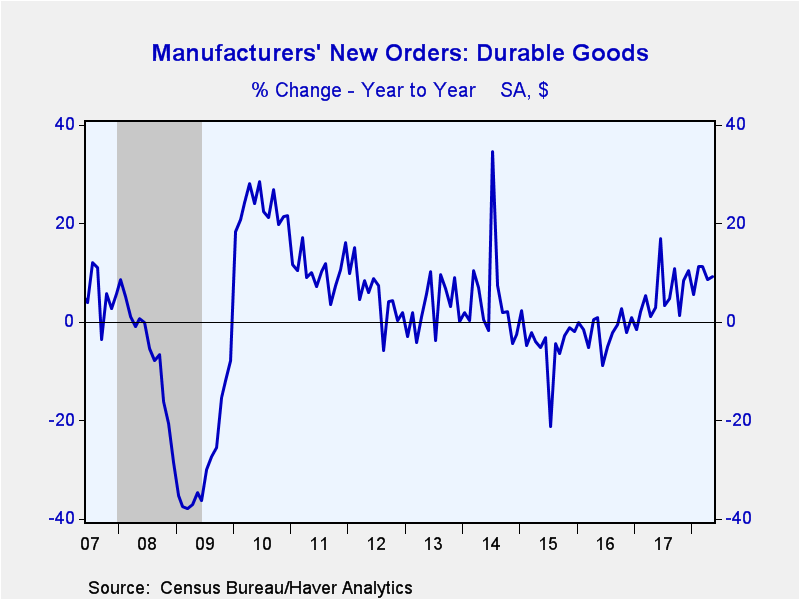 Global| Jun 27 2018
Global| Jun 27 2018U.S. Durable Goods Orders Decline
by:Tom Moeller
|in:Economy in Brief
Summary
New orders for durable goods fell 0.6% during May (+9.2% y/y) following a 1.0% April decline, revised from -1.7%. A 0.7% drop had been expected in the Action Economics Forecast Survey. During the last three months, orders have risen [...]
New orders for durable goods fell 0.6% during May (+9.2% y/y) following a 1.0% April decline, revised from -1.7%. A 0.7% drop had been expected in the Action Economics Forecast Survey. During the last three months, orders have risen at a 4.5% annual rate, down from the 13.8% pace as of February.
A 1.0% decline (+12.1% y/y) in transportation equipment orders weakened the overall orders figure as it followed a 6.1% April shortfall. Aircraft & parts orders declined 1.4% following a 24.5% drop. Orders for motor vehicles and parts also were weak and fell 4.2% (+1.2% y/y). Excluding the transportation sector altogether, durable goods orders fell 0.3% (+7.8% y/y) following a 1.9% gain, revised from 0.9%. During the last three months these orders have risen at an 8.6% annual rate.
Orders for nondefense capital goods fell 2.0% (+10.5% y/y) after a 6.5% April decline. Orders excluding aircraft eased 0.2% (+6.1% y/y) after a 2.3% gain. Defense capital goods orders increased 15.1% (41.3% y/y) following an 8.8% rise.
Within the other durable goods sectors, electrical equipment bookings fell 1.5% (+5.2% y/y) and followed three months of strong increase. Fabricated metals orders were off 1.2% (+10.8% y/y) following a 3.3% gain. Orders for primary metals slipped 0.4% (+18.1% y/y), also following three months of material improvement. Computer & electronic equipment orders slipped 0.1% (+8.3% y/y) following a 1.9% rise. Orders for computers & related products, however, declined 1.1% (-12.7% y/y) after a 5.9% rise. Machinery orders improved 0.3% (3.2% y/y) after a 1.7% rise.
Shipments of durable goods eased slightly (+5.6% y/y) following stability in April. Shipments excluding transportation equipment were little changed (7.4% y/y). Unfilled durable orders rose 0.5% (4.6% y/y), up for the fourth consecutive month. Backlogs excluding the transportation sector gained 0.5% (5.2% y/y). Durable goods inventories increased 0.3% (5.0% y/y) for the second straight month. Inventories outside of the transportation sector rose 0.2% (5.7% y/y), the weakest increase since December 2016.
The durable goods figures are available in Haver's USECON database. The Action Economics consensus forecast figure is in the AS1REPNA database.
| Durable Goods NAICS Classification | May | Apr | Mar | May Y/Y | 2017 | 2016 | 2015 |
|---|---|---|---|---|---|---|---|
| New Orders (SA, % chg) | -0.6 | -1.0 | 2.7 | 9.2 | 5.4 | -1.7 | -4.6 |
| Transportation | -1.0 | -6.1 | 6.9 | 12.1 | 3.4 | -0.7 | -6.3 |
| Total Excluding Transportation | -0.3 | 1.9 | 0.5 | 7.8 | 6.5 | -2.3 | -4.2 |
| Nondefense Capital Goods | -2.0 | -6.5 | 8.7 | 10.5 | 9.1 | -5.8 | -11.8 |
| Excluding Aircraft | -0.2 | 2.3 | -1.0 | 6.1 | 6.7 | -4.5 | -5.5 |
| Shipments | -0.1 | 0.0 | 0.8 | 5.6 | 4.0 | -2.4 | -0.8 |
| Unfilled Orders | 0.5 | 0.6 | 0.8 | 4.6 | 2.0 | -1.2 | -2.7 |
| Inventories | 0.3 | 0.3 | 0.2 | 5.0 | 4.6 | -3.0 | 0.9 |
Tom Moeller
AuthorMore in Author Profile »Prior to joining Haver Analytics in 2000, Mr. Moeller worked as the Economist at Chancellor Capital Management from 1985 to 1999. There, he developed comprehensive economic forecasts and interpreted economic data for equity and fixed income portfolio managers. Also at Chancellor, Mr. Moeller worked as an equity analyst and was responsible for researching and rating companies in the economically sensitive automobile and housing industries for investment in Chancellor’s equity portfolio. Prior to joining Chancellor, Mr. Moeller was an Economist at Citibank from 1979 to 1984. He also analyzed pricing behavior in the metals industry for the Council on Wage and Price Stability in Washington, D.C. In 1999, Mr. Moeller received the award for most accurate forecast from the Forecasters' Club of New York. From 1990 to 1992 he was President of the New York Association for Business Economists. Mr. Moeller earned an M.B.A. in Finance from Fordham University, where he graduated in 1987. He holds a Bachelor of Arts in Economics from George Washington University.










